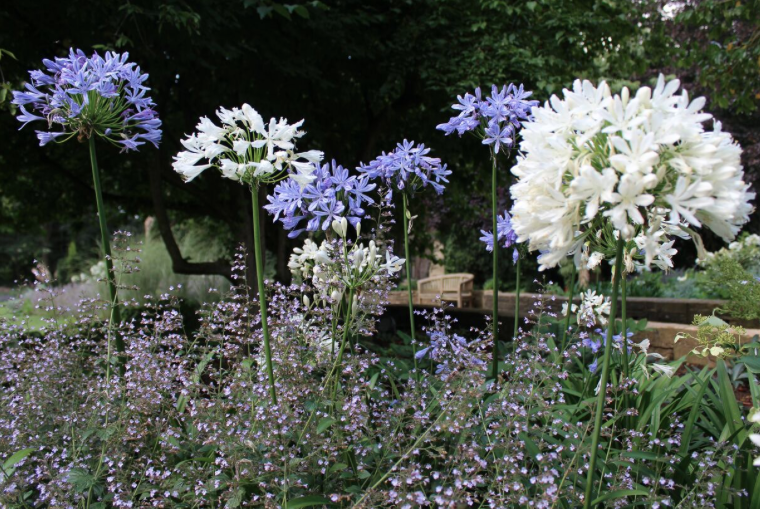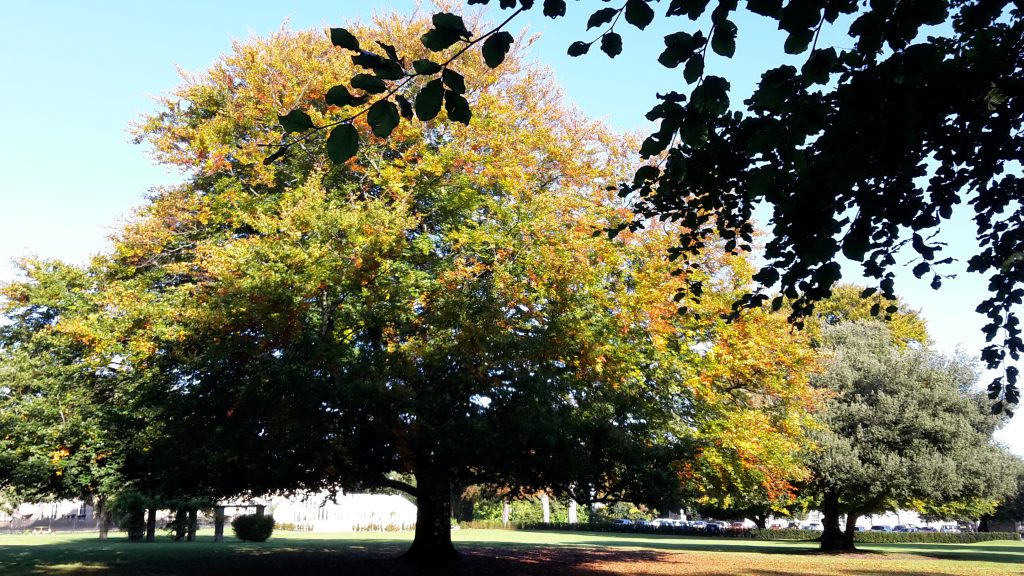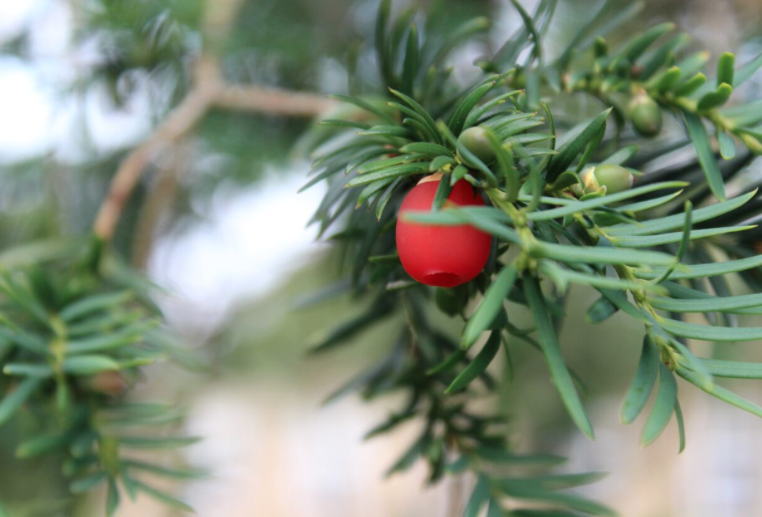
This month we asked our wonderful Head Gardener at Bowcliffe, Anna Chaffey, to hijack the Bowcliffe blog in the name of all things horticulture. As we say a final hurrah to the height of summer, we asked Anna to give us an update on what’s flourishing across the beautiful Bowcliffe grounds, plus let us know some of her top hints and tips for the avid gardeners amongst you. So without further ado here’s our official green fingered update…


“Splashes and swathes of vivid colour have come to life this summer throughout the grounds as the schemes begin to take shape! I’ve witnessed the garden for a year now and it’s been a fantastic experience to discover what plants have come up through the seasons. I’m going share some of the loveliest plants with you, and suggest what to look out for around the corner.”
My current three favourite plants:
PLANT ONE:

Latin name: Perovoskia ‘Blue Spire’
Common name: Russian Sage
Family: Lamiaceae
Description:
This is a late summer flowering deciduous subshrub/perennial reaching 1.2m in height. The foliage is strongly aromatic. Small tubular violet blue flowers on plume like panicles offer showy displays and the bold impact of colour and shape acts as a wonderful companion for other plants to complement and contrast beside it such as the ornamental grasses and perennials.

Facts of interest:
Perovskia originates from arid and open areas in the Himalayas and Afghanistan. Its name Russian Sage was said to be named after the Russian count (Count Vasily Alekseevich Perovsky (1794-1857), who introduced the plant to the West!
Growing conditions:
Perovskia grows in chalk, sand and loam soils and in poor but well drained soils, in acidic, neutral and alkaline pH conditions. It can cope with sheltered or exposed areas but should be planted in a sunny location. It has been awarded worthiness of a RHS AGM (award of garden merit).
Grow your own:
This is one Bowcliffe Hall resident that can be grown easily in home gardens as it is fully hardy and rarely gets pests or diseases. It fits into cottage garden styles or drought tolerant gravel gardens and seaside gardens. Prune back all the stem framework to about 5cm in late winter and new growth will emerge the following spring. Don’t give it any extra nutrients! To propagate this plant take semi ripe or softwood cuttings in late spring/summer.
Pollinators:
This plant has been identified by the RHS as ‘perfect for pollinators’
PLANT TWO

Latin name: Persicaria amplexicaulis ‘Rosea’
Common name: Red bistort ‘Rosea’ / Mountain fleece
Family: Polygonaceae
Description: A clump forming perennial with upright flower spikes. These soft pink flowers have been compared to graceful wands. There are a number of varieties with alternative shades in the Bowcliffe Gardens we also have a white flowering one called P.‘alba’. Planted on mass through Bowcliffe gardens they add blocks and swathes of colour into the autumn.
Facts of interest: The botanical name Persicaria is said to originate from the Latin associated with a peach tree Persicarus for the foliage likeness. Amplexicaulis is derived from the Latin amplecti meaning ‘surround, encircle or embrace’ in respect to the way the leaves clasp the stem. This is native to the Himalayas in boggy damp areas.
Growing conditions:
They grow in sun and shade from well drained to boggy locations. At Bowcliffe they are one of the plants that have taken well under the dry conifer woodland bed in front of the Blackburn Wing. They are said to do best in clay and loam, but despite our chalky soils they are establishing well here! They will also cope well with a range of pHs from alkaline, neutral and acidic in exposed or sheltered areas.
Grow your own:
They are very robust to grow! Persicaria have a strong rhizome roots acting as a ground cover and a prevention for weed growth. Although not classified as ‘invasive’, perhaps be aware they do have a tendency to spread and the root system can be difficult to remove once established! Propagate by division in autumn or spring. They suit a range of garden locations, beside ponds and streams, informal areas, cottage gardens, wildflower gardens and flower beds. Cut them back after flowering.
Pollinators:
We have noticed busy honey bees are flying in from afar to take nectar from these plants as they are full of them!
PLANT THREE:

Latin name: Agapanthus africanus ‘Albus’
Common name: African Lilly
Family: Amaryllidaceae
Description: An outstandingly beautiful and glamorous exotic perennial. The African Lilly is hardy for most of England apart from inland valleys where it sometimes suffers from extended frost damage. The eye catching flowers last for a long period and usually offer two flower heads per stem. We also have a beautiful blue Agapanthus ‘Charlotte’ at Bowcliffe, which has a deep blue vein on the centre of the petals, which also complements the colour scheme beautifully. By the chapel double borders the Agapanthus stand tall behind the charming Calamintha nepeta ‘Blue Cloud’ the combination is simple yet wonderful.

Facts of interest: Native to South Africa (Northern, Western and Eastern Cape)
Growing conditions: Ideal for a sunny, spot in a moist and well-drained soil. They will grow in clay/chalk/sand or a loam soil structure. Again this is not a not a fussy plant and will grow well in acid/alkaline or neutral soils. It can withstand temperatures down to -10°C, add winter mulch to give added protection.
Grow your own: Plant in a border or container. African Lilly is very easy to maintain, simply re-pot container plants every 3 years with fresh compost. They look great in most garden settings and suit gravel gardens, cut flower beds or borders and seaside gardens. Cut back any yellowing leaves after a hard winter and it will flourish again in spring. Please note they can take two or three years to start flowering once planted so be patient it’s worth the wait! The seed heads can be left uncut after winter for their architectural qualities.

The wow factor pictured above displaying plumes of Perovskia and Echinacea heads (pallida and purpurea)!
Planting time: Spring or early autumn. If planted in a pot pop them in a greenhouse for overwintering. For container planting use a loam based potting compost like John Innes no. 2 or 3. For the best displays feed them with a balanced liquid feed regularly once a week or fortnightly through the spring until the flowers begin to form.
Pollinators: As a bonus they are also a great plant for bees, butterflies and they attract birds.
Flowers and plants galore…
We have a buoyancy of wonderful plants and flowers across the Estate at the moment so it’s very difficult to only name a few! Some beauties are the Echinacea ‘pallida’ and E. ‘Green Jewel’.


As well as the Rusty foxgloves (Digitalis ferruginea) and Verbena bonariensis, I also have to acknowledge the ornamental grasses as we have a number of worthy ones across the gardens such as the Miscanthus ‘Morning Light’ which is a light green shade with narrow leaves finely edged with a cream margin.
We also have the compact low growing bright lime green Sesleria autumnalis which brightens up darker pockets of borders. The movement, texture and structure produced by the fine Molinia caerulea ‘transparent’ creates soft delicate plumes, which can be seen in the turning circle at the front of the Hall – stunning!


Future garden planting projects:
Autumn and spring are the best times get planting. I have recently discussed the planting schemes with the landscape architect, Alistair Baldwin and we have bounced ideas off each other to continue to improve the Bowcliffe garden establishment. I plan to tweak a few areas and bulk up some of the flowerbeds now we are improving the rabbit protection! I also have some planting ideas for the front of the hall, but I shall leave those as a surprise! We had success with some soft tip cuttings this summer, which may be large enough to plant out in the autumn or spring and we are also aiming to plant some more trees around the Blackburn Wing for the enjoyment of future generations.


What to watch out for in the next few months:
The grand parkland trees across the estate are offer pages of stories, history and curiosity! I shall have to save those for next time! Meanwhile watch out for the beautiful scenic colour changes as autumn approaches, I have now observed the garden for a year and it’s witnessed its hidden gems unfold. The parkland setting presents some stunning photos in different light levels through late summer and autumn.
East Park, early autumn 2015
The first signs of autumn have already began the Lime trees (Tilia x europea) have glimpses of golden yellow leaves, the copper Beeches are beginning to drop their first stage of crispy leaves. Last year I enjoyed watching as the coppery tones revealed themselves theatrically around the Blackburn Wing taking the picturesque landscape to a new level.


This year’s new arrival border is bursting for autumn to arrive to present some blazing red tones! I would also like to pay homage to the horticulturist that once planted our favourite Acer trees around the South and West aspects of the Hall. They steal the show with magnificent autumnal tones. We’re waiting in anticipation for the explosion of colour ahead…
Autumn 2016!
Whilst the weather is still lovely, I urge to you take a lunchtime stroll through the Estate, please do snap pictures of any plants you particularly love and seek me out if you have any gardening questions!
Anna.
Head of Bowcliffe Gardens, Anna Chaffey


